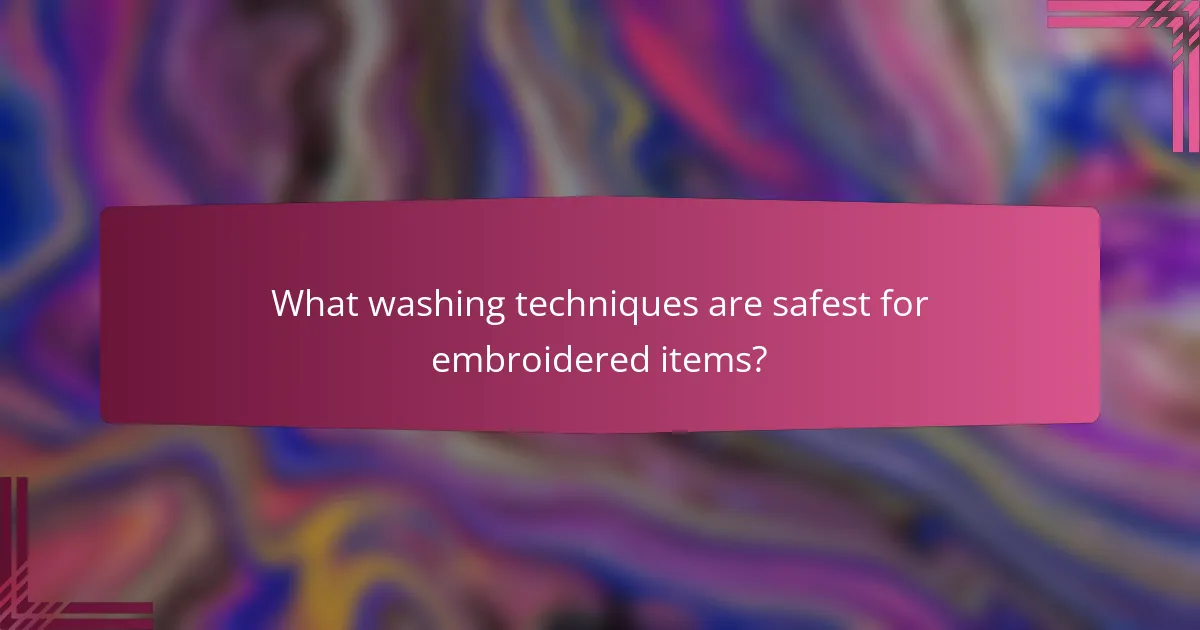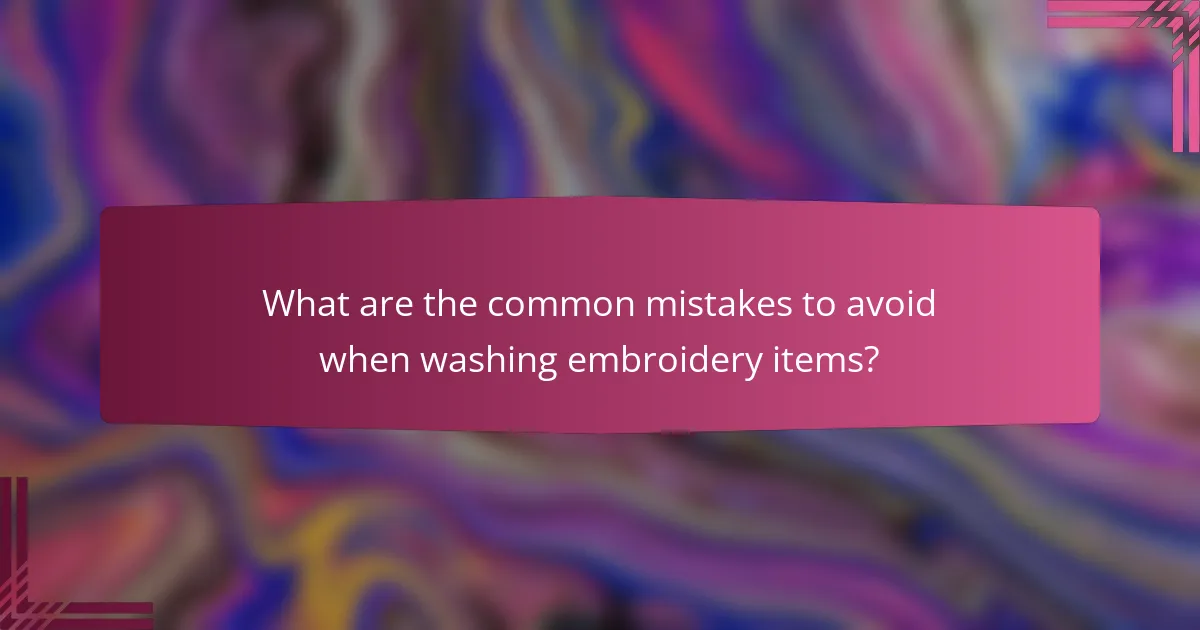
What are the best practices for washing embroidery items at home?
The best practices for washing embroidery items at home include hand washing and using cold water. Hand washing prevents damage to delicate threads. Cold water helps maintain the colors and integrity of the fabric. Use a mild detergent specifically designed for delicate items. Avoid bleach, as it can discolor and weaken the fibers. Gently scrub any stains with a soft cloth or sponge. Rinse thoroughly to remove all detergent residue. Lay the item flat to dry, avoiding direct sunlight to prevent fading. Following these practices ensures the longevity of your embroidered items.
How can you determine the right washing method for different types of embroidery?
To determine the right washing method for different types of embroidery, first identify the fabric and thread used. Cotton embroidery can typically withstand machine washing on a gentle cycle. Silk embroidery, however, requires hand washing in cold water to prevent damage.
Next, check the care label for specific instructions. Some embroidered items may have embellishments that require special care. For instance, items with beads or sequins should be placed in a mesh bag during washing.
Finally, consider the level of dirt or stain on the embroidery. Lightly soiled items may only need a rinse, while heavily soiled items may require soaking. Always test a small area first if unsure about the washing method.
What factors should you consider when choosing a washing method?
When choosing a washing method for embroidery items, consider fabric type, embroidery thread, and care instructions. Different fabrics require specific washing techniques to avoid damage. For example, delicate fabrics like silk should be hand washed, while cotton can withstand machine washing. The type of embroidery thread also impacts the washing method; synthetic threads may fade in hot water. Always check care labels for specific instructions, as they provide essential guidance for maintaining the item’s integrity. Additionally, consider the presence of embellishments, as they may require special handling. Finally, assess the level of dirt; heavily soiled items may need pre-treatment before washing.
How does the type of fabric impact the washing method?
The type of fabric significantly impacts the washing method used for embroidery items. Different fabrics have varying levels of durability, absorbency, and sensitivity to heat and agitation. For instance, delicate fabrics like silk require gentle washing methods, such as hand washing or using a delicate cycle. In contrast, sturdier fabrics like cotton can withstand machine washing on a regular cycle.
Additionally, synthetic fabrics may require cold water to prevent melting or damage, while natural fibers often tolerate warmer temperatures. The presence of embellishments, like beads or sequins, also influences the washing method. These items may necessitate protective measures, such as placing the garment in a mesh bag.
Research indicates that improper washing can lead to fabric distortion or embroidery damage. Following the appropriate washing method based on fabric type helps maintain the integrity of the item.
What tools and materials do you need for washing embroidery items safely?
To wash embroidery items safely, you need specific tools and materials. Use a mild detergent to prevent damage. A soft brush helps remove dirt without harming the fabric. A basin or sink is essential for soaking items gently. Cold water is recommended to maintain colors and prevent shrinkage. A clean towel aids in drying without friction. Finally, a mesh laundry bag protects delicate items during washing. These tools and materials ensure safe cleaning of embroidery pieces.
Which detergents are safe for embroidered fabrics?
Gentle, color-safe detergents are safe for embroidered fabrics. Brands like Woolite and Seventh Generation are recommended. These detergents are formulated to be mild and prevent damage to delicate threads. They help maintain vibrant colors without fading. Additionally, avoid bleach and harsh chemicals. These substances can weaken fibers and lead to fraying. Always check the care label for specific washing instructions. Following these guidelines helps preserve the integrity of embroidered items.
What tools can help you protect embroidery during washing?
Mesh laundry bags can help protect embroidery during washing. These bags keep embroidered items separate from other garments. They reduce friction and prevent snagging. Additionally, using a gentle cycle on your washing machine is advisable. Cold water helps maintain the integrity of the embroidery. Mild detergents are also recommended to avoid damaging threads. Finally, air drying is preferable to machine drying. This method prevents heat damage to the embroidery.

How do you prepare embroidery items for washing?
To prepare embroidery items for washing, start by checking the care label for specific instructions. Remove any loose threads or embellishments that may snag during washing. Place the embroidery item inside a mesh laundry bag to protect it. Use cold water and a gentle cycle to minimize damage. Select a mild detergent suitable for delicate fabrics. Avoid bleach and fabric softeners, as they can harm the embroidery. After washing, air dry the item flat or hang it to prevent distortion. These steps help maintain the quality and appearance of the embroidery.
What steps should you take before washing your embroidery items?
Before washing your embroidery items, check the care label for specific instructions. Different fabrics may require different washing methods. Remove any loose threads or embellishments to prevent damage. Pre-treat stains with an appropriate stain remover. Test the stain remover on a hidden area first. Place the embroidery item in a mesh laundry bag to protect it. Use a gentle detergent suitable for delicate fabrics during washing. Set the washing machine to a gentle cycle with cold water.
How do you check for loose threads or damage before washing?
Inspect the item for loose threads or damage by examining the seams and edges closely. Look for any threads that are not securely stitched or are frayed. Use your fingers to gently pull on threads to see if they come loose. Check for any visible holes or tears in the fabric. Pay attention to areas that experience more wear, like elbows or knees. If you find loose threads, trim them carefully with scissors. For any significant damage, consider repairing the item before washing. This method ensures the integrity of the embroidery is maintained during the washing process.
Why is it important to read care labels on embroidery items?
Reading care labels on embroidery items is crucial for proper maintenance. Care labels provide specific washing instructions that help preserve the integrity of the embroidery. They indicate the correct water temperature, detergent type, and drying method. Following these guidelines prevents damage such as fading, fraying, or shrinking. For example, some items may require hand washing or air drying to maintain quality. Ignoring care labels can lead to irreversible harm to the fabric and design. Thus, adherence to care labels ensures longevity and appearance of embroidered items.
How can you properly sort your embroidery items for washing?
Sort embroidery items by color, fabric type, and embellishments. Group dark colors separately from light colors to prevent dye transfer. Separate delicate fabrics from sturdier ones to avoid damage. Items with heavy embellishments should be washed with similar pieces to prevent snagging. Use mesh laundry bags for delicate embroidery to offer extra protection. Always check care labels for specific washing instructions. Following these sorting guidelines helps maintain the quality and appearance of embroidery items during washing.
What criteria should you use to sort items by color and fabric type?
Sort items by color and fabric type to ensure proper washing. For color, categorize items into light, dark, and bright shades. This prevents color bleeding and fading. For fabric type, group items by similar materials, such as cotton, polyester, or delicate fabrics. This helps maintain the integrity of each fabric during washing. Sorting by color and fabric type minimizes the risk of damage and enhances cleaning effectiveness.
How does sorting help prevent damage during the washing process?
Sorting helps prevent damage during the washing process by grouping similar fabrics and colors together. This minimizes the risk of color bleeding from darker items onto lighter ones. It also ensures that delicate fabrics are not subjected to harsh washing conditions designed for sturdier materials. For example, washing heavy towels with lightweight items can cause abrasion and wear. Additionally, sorting by fabric type allows for the selection of appropriate wash cycles and temperatures. Using the correct settings reduces the likelihood of shrinking or damaging sensitive materials. Overall, sorting enhances the longevity and appearance of the items being washed.

What washing techniques are safest for embroidered items?
The safest washing techniques for embroidered items include hand washing and using a gentle cycle in a washing machine. Hand washing minimizes agitation, which can damage delicate embroidery threads. Use cold water and a mild detergent specifically designed for delicate fabrics. If machine washing, place the item in a mesh laundry bag to protect it. Additionally, avoid bleach and fabric softeners, as they can harm the embroidery. Always air dry embroidered items to prevent heat damage from dryers. These techniques help maintain the integrity and appearance of the embroidery.
How do you hand wash embroidery items effectively?
To hand wash embroidery items effectively, fill a basin with lukewarm water and add a gentle detergent. Submerge the embroidery item completely in the water. Gently agitate the water for a few minutes to loosen dirt. Avoid scrubbing or twisting the fabric to prevent damage. Rinse the item thoroughly under cool running water until no soap remains. Press the fabric gently to remove excess water, but do not wring it out. Lay the item flat on a clean towel to dry, reshaping it as needed. This method preserves the integrity of the embroidery while cleaning it.
What is the best way to rinse and dry hand-washed embroidery items?
The best way to rinse and dry hand-washed embroidery items is to use cool water and gentle handling. First, rinse the items in cool water until all soap is removed. Avoid wringing or twisting the fabric, as this can distort the embroidery. Instead, gently press the water out using a clean towel. Lay the item flat on a dry towel to remove excess moisture. Allow it to air dry away from direct sunlight to prevent fading. This method preserves the integrity of the embroidery while ensuring proper drying.
How do you avoid damaging embroidery while hand washing?
To avoid damaging embroidery while hand washing, use cold water and a gentle detergent. Submerge the embroidered item in the water without agitating it. Gently press the fabric to remove dirt. Rinse the item thoroughly in cold water to eliminate soap residue. Do not wring or twist the fabric, as this can distort the embroidery. Lay the item flat on a clean towel to dry. Avoid hanging it, as this can stretch the fabric. Following these steps helps preserve the integrity of the embroidery.
What are the guidelines for machine washing embroidery items?
Machine washing embroidery items requires careful handling to preserve their quality. First, turn the items inside out to protect the embroidery. Use a gentle cycle to minimize agitation. Select cold water to prevent fading and shrinking. Use a mild detergent specifically designed for delicate fabrics. Avoid bleach, as it can damage the embroidery threads. Place items in a mesh laundry bag to prevent snagging. After washing, air dry the items to maintain their shape and prevent damage from heat. Following these guidelines helps ensure the longevity of embroidered items.
How do you set your washing machine for delicate items?
Set your washing machine to the delicate cycle for washing delicate items. This cycle uses a slower spin speed and gentler agitation. Select cold water to prevent damage and fading. Use a mild detergent specifically designed for delicate fabrics. Place delicate items in a mesh laundry bag to provide extra protection. Avoid overloading the machine to ensure proper cleaning. Always check the care labels on your items for specific instructions. Following these steps will help maintain the integrity of delicate fabrics.
What precautions should you take when using a washing machine?
Always check the care label on items before washing. This ensures you follow specific washing instructions. Use cold water for delicate fabrics to prevent damage. Avoid overloading the washing machine to ensure effective cleaning. Use a gentle cycle for embroidered items to protect the embellishments. Secure loose threads or embellishments to prevent snagging. Regularly clean the washing machine to avoid residue buildup. Ensure the machine is level to prevent excessive vibrations during operation.

What are the common mistakes to avoid when washing embroidery items?
Common mistakes to avoid when washing embroidery items include using hot water. Hot water can damage the threads and fabric. Another mistake is using harsh detergents. These can fade colors and weaken fibers. Avoid wringing or twisting the items. This can distort the embroidery and fabric shape. Do not use a dryer. High heat can ruin delicate embroidery. Skipping a test wash on a small area is also unwise. This helps to check colorfastness and fabric reaction. Lastly, avoid soaking items for too long. Prolonged soaking can lead to color bleeding and fabric deterioration.
How can improper washing affect the longevity of embroidery items?
Improper washing can significantly reduce the longevity of embroidery items. Harsh detergents can break down the fibers in the embroidery thread. Excessive heat from washing or drying can cause shrinkage and fading. Additionally, improper agitation can distort the embroidery design. Using the wrong water temperature can weaken the fabric. These factors can lead to premature wear and tear. Maintaining the quality of embroidery requires careful washing practices. Studies indicate that following proper washing guidelines can extend the lifespan of embroidered textiles.
What are the signs of damage from incorrect washing methods?
Signs of damage from incorrect washing methods include fading of colors, which occurs due to harsh detergents or hot water. Fabric pilling is another sign, resulting from excessive agitation during washing. Shrinkage may happen if items are washed in high temperatures, altering their original size. Distortion of shapes can occur, particularly in delicate items, due to improper drying techniques. Additionally, thread breakage can be evident, especially in embroidered areas, from using the wrong wash cycle. Lastly, the presence of water stains or spots indicates inadequate rinsing or detergent residue. These signs confirm that incorrect washing methods have negatively impacted the item.
What tips can help you maintain the quality of your embroidery items after washing?
To maintain the quality of your embroidery items after washing, follow these tips. Always wash embroidery items in cold water. Cold water helps prevent colors from bleeding and fading. Use a gentle detergent specifically designed for delicate fabrics. Avoid bleach, as it can damage the embroidery threads. Turn the items inside out before washing. This protects the embroidery from friction and wear. Air dry the items instead of using a dryer. High heat can cause shrinkage and damage the embroidery. If ironing is necessary, use a low heat setting and place a cloth over the embroidery. This prevents direct heat exposure. Store the items in a cool, dry place to avoid moisture buildup. Proper care ensures longevity and maintains the appearance of your embroidery.
How can you properly store embroidered items to prevent damage?
To properly store embroidered items and prevent damage, keep them in a cool, dry place. Avoid direct sunlight to prevent fading. Use acid-free tissue paper to cushion the items. This helps maintain the shape and prevents creasing. Store them flat or rolled, never folded. Folding can create creases that may damage the embroidery. Ensure the storage container is breathable to avoid moisture buildup. This prevents mold and mildew, which can ruin the fabric. Regularly check the storage area for pests that may cause damage. Following these guidelines helps preserve the quality of embroidered items.
What are the best practices for ironing or pressing embroidered fabrics?
The best practices for ironing or pressing embroidered fabrics include using low heat settings. High temperatures can damage delicate threads. Place a thin cloth over the embroidery to protect it. This layer prevents direct contact with the iron. Always test the heat on a small area first. This ensures the fabric can withstand the temperature. Use steam sparingly, as excessive moisture can distort the embroidery. Iron on the reverse side whenever possible. This method helps maintain the integrity of the design. Finally, avoid pulling or stretching the fabric while ironing. This preserves the shape and quality of the embroidery.
The main entity of this article is the safe washing of embroidery items at home. The article outlines best practices for cleaning embroidered fabrics, emphasizing methods such as hand washing and using cold water to prevent damage. It details how to determine the appropriate washing technique based on fabric type and embroidery thread, as well as the necessary tools and materials for safe washing. Additionally, it covers common mistakes to avoid, guidelines for machine washing, and tips for maintaining the quality of embroidery items after washing.
